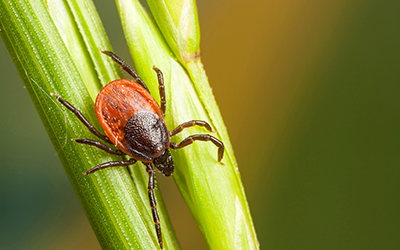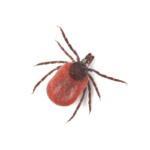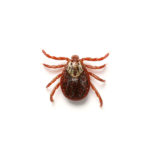 One common denominator of every Long Island summer is the ticks. Ticks just love it here. They appreciate our warm, humid climate and numerous wooded areas, so if you enjoy hiking or have pets that go outside, more likely than not you’re going to encounter some ticks. Unfortunately, ticks can be bad news, so it’s important to understand the risks that each tick species presents. Here on Long Island, there are three significant tick species you should be able to identify: deer ticks, American dog ticks, and lone star ticks.
One common denominator of every Long Island summer is the ticks. Ticks just love it here. They appreciate our warm, humid climate and numerous wooded areas, so if you enjoy hiking or have pets that go outside, more likely than not you’re going to encounter some ticks. Unfortunately, ticks can be bad news, so it’s important to understand the risks that each tick species presents. Here on Long Island, there are three significant tick species you should be able to identify: deer ticks, American dog ticks, and lone star ticks.
Most Common Ticks in Long Island
To the untrained eye, these three ticks can be difficult to tell apart. But if you, a family member, or a pet get bitten, it’s important to know what you’re dealing with so you can monitor symptoms.
Deer Ticks

- Deer ticks are most known for feeding on deer, especially near deciduous forested areas or humid spots near rivers, ponds, and streams.
- Their bodies are flat, broad, and oval-shaped.
- Usually, deer ticks are orange or brown in color, and have darker-colored legs, which is why they’re sometimes called “black-legged ticks.”
- Most measure around ⅛”.
- As deer sightings become more common in our area, so do deer ticks.
- Though they mainly feed on deer, they may also latch onto other mammals, including humans. They require humidity to survive, they’re most often found living in dense, tall grasses and vegetation, and along wooded paths and fence lines.
American Dog Ticks

- American dog ticks are one of the most common species in the United States, and odds are, you’ve probably come across them once or twice in your life.
- When they haven’t fed recently, these eight-legged pests are a brownish-tan color with white or yellow markings on their oval-shaped bodies.
- After they’ve feasted on a blood meal, their color is gray, blue, or green.
- Because of their parasitic nature, American dog ticks are often hanging out in the same areas as the warm-blooded mammals they enjoy feeding on.
- From dogs and raccoons to deer, humans, and more, these pests will feast on just about any mammal.
Lone Star Ticks

- Lone star ticks originated in Texas and the southeast, but they’ve become increasingly common in our area.
- Female lone star ticks are mainly a brown or beige shade with a white spot; males, on the other hand, have scattered spots or streaks along their bodies.
- Adults are a larger species, measuring about 1/3″ of an inch long.
- Most often, lone star ticks can be found in areas with little to no tree cover. If you’re in a grassy field or heading down a walkway with your family or pets, be on the lookout!
- They’re also attracted to humidity, so they may hide out near bodies of water such as lakes or ponds.
Which Type of Tick Is Most Dangerous?
Each of these three tick species can be dangerous. Always remove the tick as soon as possible and as safely as possible. You should also always monitor how you’re feeling after a tick bite. With that in mind, here’s how we could rank these ticks from most dangerous to least dangerous:
- Deer ticks – These ticks are notorious for transmitting Lyme disease, one of the most common tick-borne illnesses in the United States. Lyme disease can lead to a range of debilitating symptoms, including fever, fatigue, joint pain, and neurological complications. In addition to Lyme disease, deer ticks can transmit other pathogens such as Anaplasma, Babesia, and Powassan virus, each capable of causing serious health problems.
- American dog ticks – While not as well-known for transmitting diseases as deer ticks, American dog ticks can still pose significant health risks. They are primarily associated with Rocky Mountain spotted fever, a potentially severe bacterial infection that can cause fever, headache, rash, and in severe cases, organ damage or death if left untreated. American Dog Ticks may also transmit other pathogens, including Ehrlichia and Tularemia, albeit less frequently.
- Lone star ticks – Able to transmit several different diseases, most notably Southern Tick-Associated Rash Illness (STARI), which shares similarities with Lyme disease but is caused by a different bacterium. Additionally, lone star ticks can transmit Ehrlichia, which causes flu-like symptoms, as well as the Alpha-Gal allergy, a sudden onset allergy to red meat.
Tips to Avoid Ticks on Long Island
With three significant types of ticks on Long Island, you should try to reduce your risk of getting bit as much as possible. Here are a few things you can do:
- Choose Clothing Wisely: Wear long sleeves, pants, and tuck your pants into your socks or boots to create a barrier against ticks. Consider treating your clothing and outdoor gear with permethrin, an insect repellent specifically designed for fabrics.
- Use Insect Repellents: Apply insect repellents containing DEET, picaridin, or oil of lemon eucalyptus to exposed skin to repel ticks. Follow the product instructions carefully, especially when applying repellents to children. Reapply repellents as needed, particularly if you’re sweating or swimming.
- Stay on Trails: Stick to well-maintained trails and avoid wandering into dense vegetation, tall grasses, or areas with leaf litter where ticks are more likely to lurk. When hiking or walking in wooded areas, stay in the center of the trail to minimize contact with tick habitats.
- Check for Ticks Regularly: After spending time outdoors, especially in tick-prone areas, perform thorough tick checks on yourself, your children, and your pets. Promptly remove any ticks you find using fine-tipped tweezers.
- Make Your Yard Less Inviting to Ticks: Keep your grass mowed short and remove leaf litter.
- Protect Pets: Use veterinarian-recommended tick prevention products on your pets to repel ticks. Consider restricting your pets’ access to tick-prone areas or creating tick-safe zones within your yard. Check them for ticks regularly.
- Shower After Outdoor Activities: Showering within two hours of returning indoors can wash away unattached ticks and provide an opportunity to perform a thorough tick check.
What’s the Best Way to Prevent Ticks?
Aside from those tips above, the best way to prevent ticks is to guard your property against them. We recommend calling our professional tick control specialists. We can solve any existing tick issues and help you create a long-term prevention strategy.
Suburban Exterminating is an award-winning pest control company that can provide long-lasting pest control solutions to get rid of ticks in Long Island, New York. If you have ticks and need fast relief, call us today for help.
Back to Flea and Tick Exterminators – Control – Removal